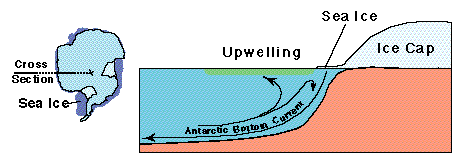"but there must be more to it than that."
It is so cold in Antarctica, where the ice meets the sea, that the ocean freezes over and makes a layer of sea ice around the edge of the continent. Ocean water does not freeze easily because it is full of salt, mostly NaCl, common table salt. But if sea water gets cold enough, it does freeze. But before it can turn into solid ice, the salt is squeezed out of the ice and into the water.
The salt which is now in the water, just under the sea ice, makes the ocean water heavier (more dense) than the surrounding water. This salty water is also very dense because it is cold. If cold, dense, heavy water is put on top of lighter water, the dense water sinks to the bottom and makes an ocean current. This deep, Antarctic bottom current slides away from the continent and keeps right on going. Because new ice is made every winter, the deep current keeps going, and going, and going. The deep current slides for thousans of miles, all the way past the equator. Some of this water even makes it to the North Atlantic, which is about as far as it can go before it must turn around and come back again.
As the professor and storyteller said, "What goes down, must come up." Water from deep in the ocean, water which is loaded with nutrients, rises up to take the place of the sinking water. It comes back up in a ring of upwelling because the whole continent is frozen, and dense, salty water is sinking around the edge. Strong winds coming down off the continent blow ocean water away from the coast and this brings water up from below and adds to the ring of upwelling.
